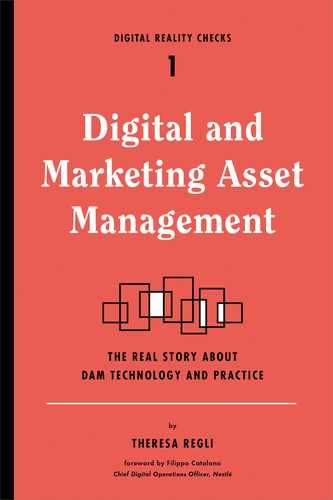0%
23Chapters
0-1Hours read
0kTotal Words
Book Description
The digital world is transitioning from text to media: photos, audio files, video clips, animations, games, and more. Enterprises of all kinds struggle with how to manage those media assets. Digital professionals who want to master the life cycles behind creating, storing, and reusing media need the inside scoop on how digital and media asset management technology really works.
Table of Contents
- Cover Page
- Title Page
- Copyright Page
- Contents
- How to Use This Book
- Foreword
- Introduction
- Chapter 1: What Is Digital and Marketing Asset Management Technology?
- Chapter 2: The Business Case for Digital and Marketing Asset Management
- Exploiting the Who, What, When, and Where of Digital and Marketing Assets
- Supporting Strategic Organizational Initiatives
- Improving Collaboration and Streamlined Creative Workflow
- Developing Better Brand Management
- Enabling Marketing Agility and Operational Excellence
- Examining DAM Costs
- A Final Note on Metadata
- Chapter 3: The DAM Maturity Model
- Chapter 4: DAM Technology Services: Asset Creation and Management
- Chapter 5: DAM Technology Services: Search, Retrieval, and Navigation
- Chapter 6: DAM Technology Services: Asset Assembly and Delivery
- Chapter 7: DAM Technology Services: Architecture and Administration
- Chapter 8: Cloud, On-Premise, or Hybrid? DAM Delivery Models
- Chapter 9: You’re Not Just Buying a Tool: Strategic Considerations
- Chapter 10: Universal Scenarios: The Key to Comparing Technologies
- Chapter 11: Mixology: DAM in the Digital Marketing Cocktail
- Index
- Acknowledgments
- About the Author
